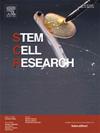诱导多能干细胞系NIMHi012-A的鉴定来源于一名SCN1A基因致病性变异的癫痫患者的pbmc
IF 0.7
4区 医学
Q4 BIOTECHNOLOGY & APPLIED MICROBIOLOGY
引用次数: 0
摘要
我们报告了iPSC细胞系NIMHi012-A的成功表征,该细胞系产生于一例全面性癫痫伴发热性癫痫发作(GEFS+)患者的pmcs。无支原体细胞表达多能性标记物,具有三期分化潜能,核型正常。该细胞系将作为研究疾病机制和开发新的患者特异性治疗策略的平台。本文章由计算机程序翻译,如有差异,请以英文原文为准。
Characterisation of the induced pluripotent stem cell line NIMHi012-A derived from PBMCs of an epilepsy patient with a pathogenic variant in SCN1A gene
We report successful characterisation of the iPSC line NIMHi012-A, generated from the PBMCs of a patient with generalized epilepsy with febrile seizures plus (GEFS+). The mycoplasma-free cells expressed pluripotency markers, showed trilineage differentiation potential and had a normal karyotype. This cell line will serve as a platform to investigate the disease mechanism and develop novel patient-specific therapeutic strategies.
求助全文
通过发布文献求助,成功后即可免费获取论文全文。
去求助
来源期刊

Stem cell research
生物-生物工程与应用微生物
CiteScore
2.20
自引率
8.30%
发文量
338
审稿时长
55 days
期刊介绍:
Stem Cell Research is dedicated to publishing high-quality manuscripts focusing on the biology and applications of stem cell research. Submissions to Stem Cell Research, may cover all aspects of stem cells, including embryonic stem cells, tissue-specific stem cells, cancer stem cells, developmental studies, stem cell genomes, and translational research. Stem Cell Research publishes 6 issues a year.
 求助内容:
求助内容: 应助结果提醒方式:
应助结果提醒方式:


